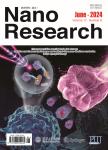Synthesis, characterization, theoretical investigation, and properties of monoclinic-phase InWO4 hollow nanospheres
Synthesis, characterization, theoretical investigation, and properties of monoclinic-phase InWO4 hollow nanospheres作者机构:Key Laboratory of Functional Inorganic Material Chemistry Ministry of Education School of Chemistry and Materials ScienceHeilongjiang University Harbin 150080 China
出 版 物:《Nano Research》 (纳米研究(英文版))
年 卷 期:2018年第11卷第9期
页 面:4664-4672页
核心收录:
学科分类:07[理学] 0701[理学-数学] 070101[理学-基础数学]
基 金:国家自然科学基金 the Innovative Project of Postgraduate of Heilongjiang University
主 题:InWO4 rare earth hollow nanospheres luminescence
摘 要:As a newly discovered member of the ttmgstate famil3~ InWO4 hollow nanospheres with a monoclinic wolframite structure were synthesized successfully. The crystal phase of InWO4 was investigated via a combination of CASTEP geometric optimization and experimental simulation. InWO, has a space group of P2/c with two InWO, formula units per unit cell. The optimized cell dimensions are a = 5.16 A, b = 5.97 A, and c = 5.23 A, with a = 90°, β= 92.11°, 7 = 90°, giving a unit cell volume of 161.10 A^3, which is consistent with the experimental measurements. More importantly, InWO4 was a promising host material for different Ln^3+ (Ln = Eu and Yb/Er) ions. For InWO4:Yb^3+/Er^3+ excited at 980 nm, transitions from the ^4G11/2 (384 nm), ^2H9/2 (411 nm), and ^4F7/2 (487 nm) levels to the ground state (^4I15/2) of Er^3+ were observed. In addition to the aforementioned properties, the InWO4 hollow nanospheres can be used to improve the performance of dye-sensitized solar cells, which is chiefly attributed to their light scattering.



